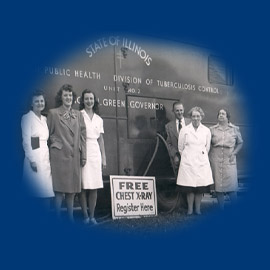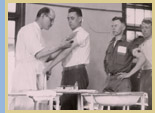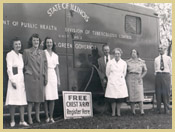
|
1940
 The Department assumes the responsibility for
licensing and regulating maternity hospitals. The Department assumes the responsibility for
licensing and regulating maternity hospitals.
1941
For the first time, state funds are designated to the Department for the fight
against tuberculosis.
1942
An emergency maternity and infant care program, financed by the Department, is
hastily implemented to assist the wives and babies of World War II servicemen.
 About 25 percent of the
state's young men are rejected for military duty, causing Gov. Dwight H. Green
to instruct the Department to establish programs aimed at correcting the
disqualifying defects wherever possible. About 25 percent of the
state's young men are rejected for military duty, causing Gov. Dwight H. Green
to instruct the Department to establish programs aimed at correcting the
disqualifying defects wherever possible.
Due to possible enemy action during World War II, an "emergency water
corps" is organized by the Department to protect local water supplies in
the event of disaster or sabotage.
1943
Legislation unanimously passes authorizing counties, by referendum or
resolution of the county board, to establish and maintain county and multiple
county health departments.
1945
A policy is adopted to provide state subsidies to local health departments that
meet specific program standards and personnel qualifications.
The nursing home licensing law gives the Department the power to prescribe and
enforce rules and regulations as to operations and minimum standards for
location, construction, personnel, sanitation and diet at these facilities.
1946
 With much fanfare, Gov. Dwight H. Green
becomes the first person to have a chest X-ray in one of two new Department
mobile tuberculosis units. With much fanfare, Gov. Dwight H. Green
becomes the first person to have a chest X-ray in one of two new Department
mobile tuberculosis units.
1947
An appropriation of $6.7 million authorizes the Department to build and operate
tuberculosis sanatoria. State sanitariums are eventually constructed in Mount
Vernon (1951) and Chicago (1953).
After a survey by the Department to determine areas of the state with hospital
needs, communities identified are eligible for federal and state grants equal
to two-thirds of hospital construction costs. The first to start construction
is Clay County Hospital. By 1962, 155 projects costing nearly $300 million are
approved.
The Department starts fluoridation of public water supplies as a way to reduce
dental caries.
The General Assembly authorizes the Department to establish and operate a
first-aid station in the state Capitol. |
|